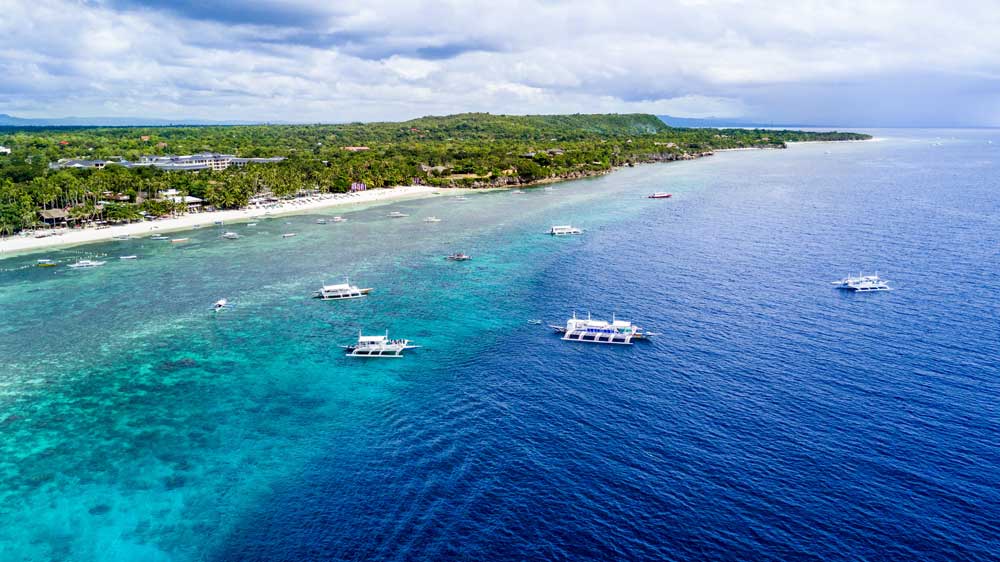
Mergulhe na experiência de live aboard em Visayas nas Filipinas
Your adventure on a liveaboard will unveil the wonders beneath the waves, revealing a world of vibrant coral gardens, mysterious wrecks, and schools of whimsical fish dancing in the gentle currents. The Visayas region has a rich history, with each island telling tales of the ancient civilizations that once thrived here. The blend of cultural heritage and natural beauty creates a unique backdrop to your underwater exploration.
Sobre o Liveaboard Visayas
From the elusive thresher sharks of Malapascua to the mesmerizing sardine runs of Moalboal, the Visayas promises an unforgettable diving adventure amidst the heart of the Philippines’ marine biodiversity.
The Visayas region in the Philippines is a diver's paradise, offering a range of unique diving experiences across its various sites. Best experienced with a Visayas liveaboard, here's a closer look at some of the prime diving destinations in this region:
Malapascua: Known for its thresher shark encounters, Malapascua Island is a jewel in the Visayas diving crown. Apart from thresher sharks, divers also frequently spot manta rays, hammerhead sharks, and a rich variety of smaller marine creatures. The dive sites here cater to all levels of divers, with Monad Shoal being the most famous for shark sightings.
Ilha do Pescador (Moalboal): A marine park located near Moalboal, Pescador Island is celebrated for its vibrant coral walls and abundant marine life. The Cathedral, a cavern dive site, is one of the highlights here. The island is also home to schools of sardines, frogfish, and occasionally, whitetip sharks.
Ilha Sumilon: Known for its crystal clear waters, Sumilon Island offers stunning coral landscapes and a variety of marine life including reef sharks, rays, and a multitude of fish species. The island also has a marine sanctuary which has greatly helped in preserving the local marine ecosystem.
Moalboal: Além da Ilha Pescador, Moalboal em si é um centro de mergulho em Filipinas known for its sardine runs. The sight of millions of sardines swirling together in unison is a spectacle not to be missed. There are also numerous dive sites here suitable for all levels of divers, featuring beautiful coral gardens and diverse marine life.
Ilha Apo (Negros): Leading the diving scene in Negros, Apo Island is a protected marine sanctuary. It's a haven for divers, boasting healthy coral reefs teeming with colorful marine life. Popular dive sites include Coconut Point and Chapel Point, each offering unique underwater landscapes and a variety of marine species.
Bohol: The waters around Bohol are a playground for divers. Sites like Alona Beach and Panglao Island offer a mixture of wall, drift, and macro diving. The area is rich in coral gardens, small caves, and overhangs, housing a diverse range of marine life from nudibranchs to reef sharks.
Ilha Balicasag: A small island off the coast of Bohol, Balicasag is famed for its wall dives. The island’s steep walls are adorned with beautiful corals and are home to a variety of marine species including turtles, barracudas, and jacks. Diver's Heaven and Black Forest are among the popular dive sites here.
Quando ir para Visayas?
The best time to visit the Visayas region in the Philippines for diving would be outside the typhoon season and the rainiest months, which occur from late November through February.
Durante este período, especialmente de dezembro a fevereiro, as Visayas orientais, incluindo Cebu, Bohol e Leyte, experimentam um clima úmido devido à estação Amihan (monção nordeste), trazendo fortes chuvas, afetando particularmente os locais de mergulho no sul de Leyte. Os tufões também são comuns de novembro a janeiro, afetando notavelmente Leyte e a parte norte de Cebu.
The waters can get rough during either the northeast or southwest monsoon (Habagat) as winds stir up the waves, potentially affecting the diving conditions. However, it's mentioned that dive trips are still recommended year-round as dive operators are knowledgeable about the seasonal variations and can guide divers to sheltered areas offering great diving experiences despite the prevailing weather conditions.
Para uma experiência de mergulho mais previsível e agradável, planear a sua visita entre março e início de novembro pode ser o ideal. Especificamente, alguns live aboards mudam suas operações para Tubbataha de março a junho, aproveitando a temporada de mergulho mais curta, o que também indica que esse período é favorável para o mergulho na região de Visayas.




